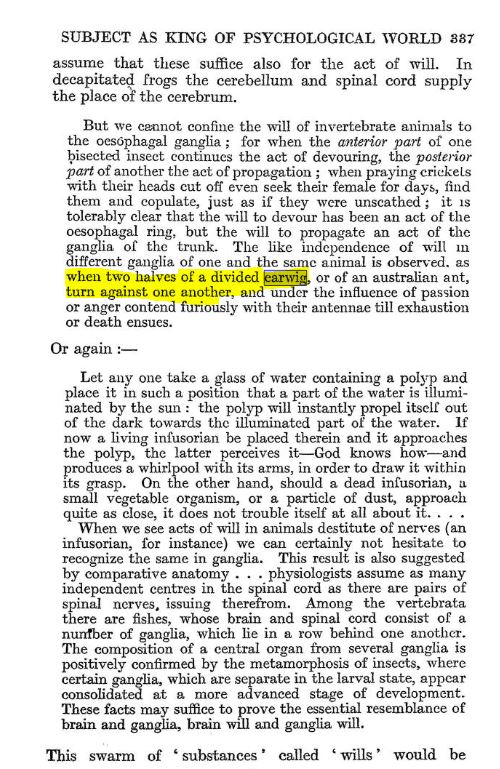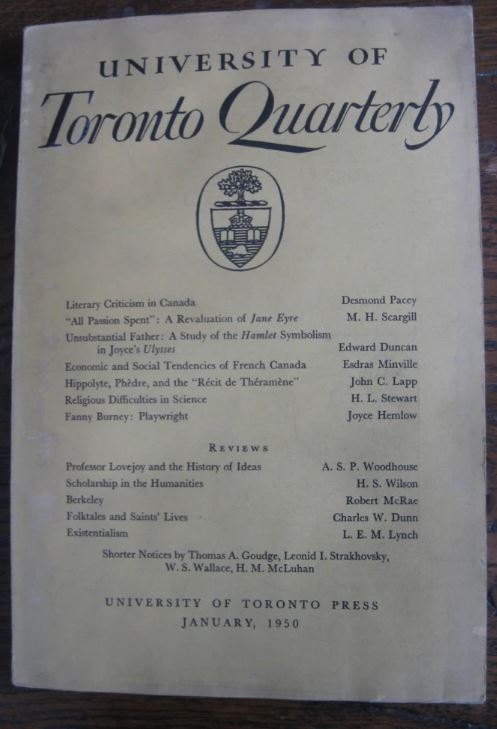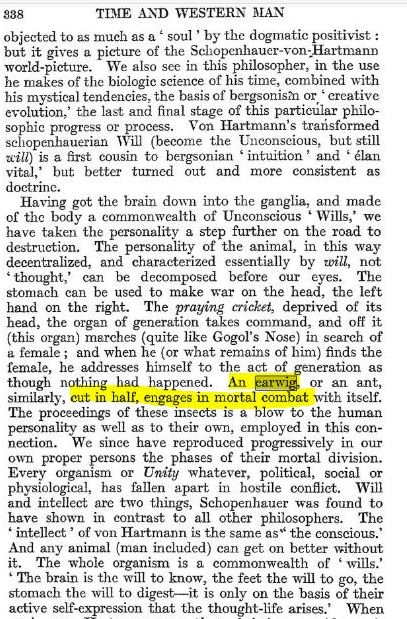A note left by McLuhan in a 1950 issue of UTQ1 has been transcribed by Andrew McLuhan. The note ends with the striking aperçu: “The earwig when bisected fights itself.”
The ultimate source of this observation must have been Eduard von Hartmann’s Philosophie des Unbewussten (Philosophy of the Unconscious) from 1869 (translation 1884):
the anterior part of one bisected insect continues the act of devouring, and the posterior part of another the act of propagation. (…) Crickets with their heads cut off even seek their females for days, find them and copulate, just as if they were unscathed. (…) The like independence of the will in the different ganglia of one and the same animal is observed, when the two halves of a divided earwig (…) turn against one another, and, under the unmistakable influence of the passion of anger and lust of fighting, contend furiously with their antennæ till exhaustion or death ensues. (trans 62)
Wyndham Lewis was particularly struck by this passage. He cited it in successive books in successive years (The Art of Being Ruled in 1926 and Time and Western Man in 1927) and, in the latter, on successive pages — at length on TWM 337 directly from von Hartmann:

and then again on TWM 338:
McLuhan’s note — “the earwig when bisected fights itself” — is particularly close to Lewis’ formulation on TWM 338 — “an earwig (…) cut in half engages in mortal combat with itself”. But von Hartmann’s formulation (in translation) is also not far off — “the two halves of a divided earwig (…) turn against one another”.
Lewis referred to the same von Hartmann passage a year earlier than TWM in his 1926 Art of Being Ruled:
Continuity, in the individual as in the race, is the diagnostic of a civilized condition. If you can break this personal continuity in an individual, you can break him. For he is that continuity. It is against these joints and sutures of the personality that an able attack will always be directed. You can divide a person against himself, unless he is very well organized: as the two halves of a severed earwig become estranged and fight with each other when they meet.
McLuhan closely studied these two 1926/1927 books of Lewis after meeting him in the summer of 1943. His 1944 ‘Lemuel in Lilliput’ quotes from both of them extensively.
Although Lewis as the source of McLuhan’s awareness of the image of the divided earwig fighting with itself seems clear, it would be interesting to know more about the same question in regard to both Lewis and Joyce. Did Lewis get the image directly or indirectly from von Hartmann? If indirectly, from whom?
The case with Joyce is of the utmost interest. In 1923 he was already writing (in the so-called Finn’s Hotel) about ‘Earwicker’ and the earwig. At that time he surely knew, directly or indirectly, of the earwig image in von Hartmann. Was this the reason he was so struck by the ‘Earwicker’ name when he came across it on holiday in 1923 in Sussex?2 The whole genesis of Finnegans Wake seems to be at stake in these questions.
 University of Toronto Quarterly 19:2, January 1950. McLuhan himself had a contribution in this issue, a review of R.W. Stallman, Essays in Criticism 1920-1948. ↩
University of Toronto Quarterly 19:2, January 1950. McLuhan himself had a contribution in this issue, a review of R.W. Stallman, Essays in Criticism 1920-1948. ↩- See Peter Chrisp’s wonderful post on ‘James Joyce in Bognor Regis‘. ↩
